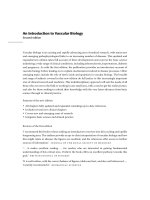A Practical Guide to Clinical Virology Second Edition - part 1 ppsx
Bạn đang xem bản rút gọn của tài liệu. Xem và tải ngay bản đầy đủ của tài liệu tại đây (2.86 MB, 24 trang )
Made by Cellculture
06 Jun 2003
www.dnathink.com
www.bioin.org
www.biolover.com
A Practical Guide to Clinical Virology
Second Edition
A Practical Guide to Clinical Virology. Edited by L. R. Haaheim, J. R. Pattison and R. J. Whitley
Copyright
2002 John Wiley & Sons, Ltd.
ISBNs: 0-470-84429-9 (HB); 0-471-95097-1 (PB)
A Practical Guide to Clinical Virology
Second Edition
Edited by
L. R. Haaheim
Professor of Medical Microbiology, Depar tment of Microbiology and
Immunology, University of Bergen, Bergen, Norway
J. R. Pattison
Director of Research, Analysis and Information, Department of Health,
London, UK
R. J. Whitley
Department of Pediatrics, The Children’s Hospital,
The University of Alabama at Birmingham,
Birmingham, USA
Copyright & 2002 John Wiley & Sons Ltd, The Atrium, Southern Gate, Chichester,
West Sussex PO19 8SQ, England
Telephone (+44) 1243 779777
First edition published 1989
Reprinted February 1993, November 1994
This book is based on Ha
˚
ndbok i Klinisk Virologi edited by
Gunnar Haukenes and Lars R. Haaheim, 1983.
All rights reserved. Exclusive market rights in Scandinavia and Finland are held by:
Alma Mater Forlag AS, PO Box 57 Universitetet, 5027 Bergen, Norway
ISBN 0 471 91978 0 (World excluding Scandinavia and Finland)
ISBN 82 419 0038 4 (Scandinavia and Finland)
Cartoons Copyright & 1989 Arnt J. Raae
Email (for orders and customer service enquiries):
Visit our Home Page on www.wiley.co.uk or www.wiley.com
All Rights Reserved. No part of this publication may be reproduced, stored in a retrieval system or
transmitted in any form or by any means, electronic, mechanical, photocopying, recording, scanning or
otherwise, except under the terms of the Copyright, Designs and Patents Act 1988 or under the terms of a
licence issued by the Copyright Licensing Agency Ltd, 90 Tottenham Court Road, London W1P 0LP,
UK, without the permission in writing of the Publisher. Requests to the Publisher should be addressed to
the Permissions Department, John Wiley & Sons Ltd, Baffins Lane, Chichester, West Sussex PO19 1UD,
England, or emailed to , or faxed to (+44) 1243 770571.
This publication is designed to provide accurate and authoritative information in regard to the subject
matter covered. It is sold on the understanding th at the Publisher is not engaged in rendering professional
services. If professional advice or other expert assistance is required, the services of a competent
professional should be sought.
Other Wiley Editorial Offices
John Wiley & Sons Inc., 605 Third Avenue, New York, NY 10158-0012, USA
Jossey-Bass, 989 Market Street, San Francisco, CA 94103-1741, USA
Wiley-VCH Verlag GmbH, Pappalallee 3, D-69469 Weinheim, Germany
John Wiley & Sons Australia Ltd, 33 Park Road, Milton, Queensland 4064, Australia
John Wiley & Sons (Asia) Ptd Ltd, 2 Clementi Loop #02-01, Jin Xing Distripark, Singapore 129809
John Wiley & Sons Canada Ltd, 22 Worcester Road, Etobicoke, Ontario, Canada M9W 1L1
British Library Cataloguing in Publication Data
A catalogue record for this book is available from the British Library
ISBN 0 470 84429 9 ppc
ISBN 0 471 95097 1 pbk
Typeset by Dobbie Typesetting Ltd, Tavistock, Devon
Printed and bound in Great Britain by Biddles Ltd, Guildford, Surrey
This book is printed on acid-free p aper responsibly manufactured from sustainable forestry in which at
least two trees are planted for each one used for paper production.
CONTENTS
Contributors ix
Preface xi
Preface to 1st Edition xiii
Abbreviations xv
References for Further Reading xvii
1 Classification and Nomenclature of Human and Animal Viruses
Y. Ghendon 1
2 Viruses and Disease
G. Haukenes and J. R. Pattison 7
3 Laboratory Diagnosis of Virus Infections
G. Haukenes and R. J. Whitley 15
4 Antiviral Drugs
J. S. Oxford and R. J. Whitley 21
5 Virus Vaccines
L. R. Haaheim and J. R. Pattison 37
6 Enteroviruses: Polioviruses, Coxsackieviruses, Echoviruses
and Newer Enteroviruses
A L. Bruu 45
7 Polioviruses
A L. Bruu 47
8 Coxsackieviruses, Echoviruses and Enteroviruses 29–34 and 68–71
A L. Bruu 55
9 Rhinoviruses and Coronaviruses
I. Ørstavik 61
10 Influenzaviruses
L. R. Haaheim 67
11 Parainfluenzaviruses
A. B. Dalen 75
v
12 Mumps Virus
B. Bjorvatn and G. Haukenes 81
13 Respiratory Syncytial Virus (RSV)
G. A
˚
nestad 89
14 Measles Virus
N. A. Halsey 97
15 Rubella Virus
G. Haukenes 105
16 Adenoviruses
I. Ørstavik and D. Wiger 113
17 Rotaviruses
I. Ørstavik and E. Kjeldsberg 121
18 Herpes Simplex Virus (HSV1 and HSV2)
E. Tjøtta and G. Hoddevik 127
19 Varicella-Zoster Virus (VZV)— Varicella
A. Winsnes and R. Winsnes 137
20 Varicella-Zoster Virus (VZV)— Zoster
A. Winsnes and R. Winsnes 145
21 Cytomegalovirus (CMV)
A. B. Dalen 149
22 Epstein–Barr Virus (EBV)
E. Tjøtta 157
23 Human Herpesvirus 6 (HHV-6)
J. A. McCullers 167
24 Hepatitis A Virus
M. Degre
´
173
25 Hepatitis B Virus
G. L. Davis 179
26 Hepatitis C Virus
G. L. Davis 185
27 Hepatitis D Virus
G. L. Davis 191
vi
28 Hepatitis E Virus
M. Degre
´
195
29 Emerging Hepatitis Viruses
G. L. Davis 201
30 Parvovirus B19
J. R. Pattison 203
31 Retroviruses
A. B. Dalen 209
32 Human Immunodeficiency Virus (HIV)
B. A
˚
sjo
¨
213
33 Human T-Cell Lymphotropic Virus Type I and II
R. J. Whitley and G. Shaw 221
34 Tick-borne Encephalitis (TBE) Virus
T. Traavik 227
35 Hantaviruses—HFRS and HPS
D. Wiger 235
36 Haemorrhagic Fever Viruses
G. Haukenes 241
37 Rabies Virus
B. Bjorvatn and G. Haukenes 245
38 Human Papillomavirus (HPV)
T. Traavik 251
39 Human Polyomaviruses
T. Traavik 259
40 Slow Viruses
G. Haukenes 263
41 Poxviruses
G. Haukenes 267
42 Clinical Syndromes
G. Haukenes and J. R. Pattison 271
Index 277
vii
THE TYPING POOL
Dr Gunnar Hoddevik, Department of Virology, National Institute of Public
Health, Geitmyrsveien 75, N-0462 Oslo, Norway
Dr Elisabeth Kjeldsberg, Prof Dahls gate 47, N-0367 Oslo , Norway
Dr Jonathan A. McCullers, Department of Infectious Diseases, St Jude
Children’s Research Hospital, 332 N Lauderdale Street, Memphis,
TN 38105-2794, USA
Tel: +1901 495 5164; Fax: +1901 495 3099; E-mail:
Dr Ivar Ørstavik, Chief Medical Officer, Division of Infectious Disease
Control, Norwegian Institute of Public Health, P.O. Box 4404 Nydalen, N-
0403 Oslo, Norway
Tel: +47 22 04 22 85; Fax: +47 22 04 24 47
E-mail:
Professor John S. Oxford , Academic Virology, Department of Medical
Microbiology, St Bartholomew’s and the Royal London School of Medicine
and Dentistry, Turner Street, Whitechapel, London E1 2AD, UK
Tel: +44 (0)207 375 2498
Professor Sir John R. Pattison, Director of Research, Analysis and
Information, Department of Health, Richmond House, 79 Whitehall,
London SW1A 2NS, UK
E-mail:
Dr George Shaw, The University of Alabama at Birmingham, Department of
Medicine, Birmingham, AL 35294, USA
Dr Enok Tjøtta, Micro-Invent AS, Høyenhallsvingen 23, N-0667 Oslo, Norway
Tel: +47 22 26 54 90
Professor Terje Traavik, Institute of Medical Biology, Department of Virology,
N-9037 University of Tromsø, Norway
Professor Richard J. Whitley, The University of Alabama at Birmingham,
Department of Pediatrics, The Children’s Hospital Ambulatory Care Center
616, 1600 7th Avenue South, Birmingham, AL 35294-0011, USA
Tel: 001 205 934 5316; Fax: 001 205 934 8559; E-mail: r.whitley@peds.
uab.edu
Donna Wiger, MSc, The Norwegian Medicines Agency, Sven Oftedals vei 6,
N-0950 Oslo, Norway
E-mail:
Drs Randi and Arnt Winsnes , The Norwegian Medicines Agency, Sven Oftedals
vei 6, N-0950 Oslo, Norway
E-mail: ; ;
x
HELLO FOLKS!
AIDS Acquired immunodeficiency syndrome
Anti-HBc
Anti-HBe
}
Antibody against the hepatitis B virus core, e and surface
Anti-HBs
antigens
Arboviruses Arthropod-borne viruses
ARC AIDS-related complex
ATL Adult T-cell leukaemia/lymphoma
AZT Azidothymidine
BL Burkitt’s lymphoma (EBV)
BKV Strain of human polyoma virus
CE California encephalitis (virus)
CF(T) Complement fixation (test)
CJD Creutzfeldt–Jakob diseas e
CMV Cytomegalovirus
CSF Cerebrospinal fluid
EBNA EBV nuclear antigen
EBV Epstein–Barr virus
ELISA Enzyme-linked immunosorbent assay
F protein Fusion protein
Fr. French
Ger. German
Gr. Greek
H Haemagglutinin
HAM HTLV-associated myelopathy
HAV Hepatitis A virus
HBcAG
HBeAG
}
Hepatitis B virus core, e and surface antigens, respectively
HBsAG
HBIG Hepatitis B immunoglobulin
HBV Hepatitis B virus
HCV Hepatitis C virus
HDV Hepatitis D (delta) virus
HEV Hepatitis E virus
xv
HFRS Haemorrhagic fever with renal syndrome
HI(T) Haemagglutination inhibition (test)
HIV Human imm unodeficiency virus
HPS Hantavirus pulmonary syndrome
HPV Human papilloma virus
HSV Herpes simplex virus
HTLV Human T-cell leukaemia virus
IF(T) Immune fluorescence (test)
IgA
IgG
}
Immunoglobulins of the classes A, G and M, respectivel y
IgM
IL-2 Interleukin 2
JCV Strain of human polyoma virus
Lat. Latin
LCR Ligase chain reaction
N Neuraminidase
NANB Non-A, non-B (hepatitis)
NE Nephropathia epidemica
NP Nucleoprotein
NPC Nasopharyngeal carcinoma (EBV)
NT Neutralization test
PCR Polymerase chain reaction
PGL Persistent generalized lymphadenopathy (HIV infection)
PHA Passive (indirect) haemagglutination
PML Progressive multifocal leukoencephalopathy (polyoma virus)
RIA Radioimmunoassay
RIBA Radioimmunoblot assay
RSV Respiratory syncytial virus
RT-PCR Reverse transcriptase polymerase chain reaction
SRH Single radial haemol ysis
SSPE Subacute sclerosing panencephalitis (measles virus)
TBE Tick-borne encephalitis (virus)
TSP Tropical spastic paraparesis
URTI Upper respiratory tract infection
VCA Viral capsid antigen (EBV)
VZIG Specific VZ-immunoglobulin
VZV Varicella–zoster virus
xvi
REFERENCES FOR
FURTHER READING
Collier L, Oxford J. Human Virology, 2nd edn. Oxford University Press, Oxford, 2000.
Knipe DM, Howley PM et al. (eds). Field’s Virology, 4th edn. Lippincott Williams &
Wilkins, Philadelphia, 2001.
Zuckerman AJ, Banatvala JE, Pattison JR (eds). Principles and Practice of Clinical
Virology, 4th edn. John Wiley & Sons, Chichester, 1999.
xvii
CLASSIFIED MATERIAL
A Practical Guide to Clinical Virology. Edited by L. R. Haaheim, J. R. Pattison and R. J. Whitley
Copyright
2002 John Wiley & Sons, Ltd.
ISBNs: 0-470-84429-9 (HB); 0-471-95097-1 (PB)
2
Table 1.1 continued
Family
Subfamily
Genus Examples
Partial double-stranded partial single-stranded DNA, non-enveloped virions
Hepadnaviridae Orthohepadnavirus Human hepatitis B virus
Single-stranded DNA, non-enveloped virions
Parvoviridae
Chordoparvovirinae Erythrovirus Parvovirus B19
Double-stranded RNA, non-enveloped virions
Reoviridae Reovirus Reovirus types 1, 2, 3
Rotavirus Human rotaviruses (A and B)
Orbivirus Orungovirus, Kemerovo virus
Coltivirus Colorado tick fever virus
Single-stranded RNA, enveloped virions without DNA step in replication cycle
(a) Positive-sense genome
Togaviridae Alphavirus Sindbis virus (arbovirus group A)
Rubivirus Rubellavirus
Flaviviridae Flavivirus Yellow fever virus (arbovirus group
B)
Unnamed Hepatitis C virus
Coronaviridae Coronavirus Human coronavirus
(b) Negative-sense, non-segmented genome
Paramyxoviridae
Paramyxovirinae Paramyxovirus Parainfluenzaviruses 1 and 3
Morbillivirus Measles virus
Rubulavirus Mumps virus, parainfluenzaviruses 2
and 4
Pneumovirinae Pneumovirus Respiratory syncytial virus
Rhabdoviridae Lyssavirus Rabies virus
Vesiculovirus Vesicular stomatitis virus
Filoviridae Filovirus Marburg and Ebola viruses
(c) Negative-sense, segmented genome
Orthomyxoviridae Influenzavirus A, B Influenza A and B viruses
Influenzavirus C Influenza C virus
Bunyaviridae Bunyavirus Bunyamwera virus, La Crosse virus,
California encephalitis virus
Phlebovirus Sandfly fever virus, Sicilian virus,
Rift Valley fever virus, Uukuniemi
virus
Nairovirus Crimean–Congo haemorrhagic fever
virus
Hantavirus Hantaan virus, Seoul virus, Sin
Nombre virus, Puumala virus
continued
3
Table 1.1 continued
Family
Subfamily
Genus Examples
Arenaviridae Arenavirus Lymphocytic choriomeningitis virus,
Lassa virus, Venezuelan
haemorrhagic fever virus
Single-stranded RNA, enveloped virions with DNA in the replication cycle
Retroviridae HTLV–BLV group Human T-cell leukemia/
lymphotropic virus (HTLV-1 and
HTLV-2)
Spumavirus Human foamy virus
Lentivirus Human immunodeficiency viruses
(HIV-1 and HIV-2)
Single-stranded RNA, positive-sense, non-enveloped virions
Picornaviridae Enterovirus Polioviruses 1–3, coxsackieviruses
A1–22, A24, B1–6, echoviruses 1–
7, 9, 11–27, 29–33, enteroviruses
68–71
Hepatovirus Hepatitis A virus
Rhinovirus Rhinoviruses 1–100
Caliciviridae Calicivirus Norwalk agent, hepatitis E virus?
4
Figure 1.1 MORPHOLOGICAL FORMS OF VIRUSES: 1. poliovirus, naked RNA
virus with cubic symmetry; 2. herpesvirus, enveloped DNA virus with cubic
symmetry; 3. influenzavirus, enveloped RNA virus with helical symmetry; 4.
mumps virus, enveloped RNA virus with helical symmetry—the helical
nucleocapsid is being released; 5. vesicular stomatitis virus, morphologically
similar to rabies virus; 6. orfvirus, also with a complex symmetry. Bars represent
100 nm (Electron micrographs courtesy of E. Kjeldsberg)
A LOAD OF TROUBLE
A Practical Guide to Clinical Virology. Edited by L. R. Haaheim, J. R. Pattison and R. J. Whitley
Copyright
2002 John Wiley & Sons, Ltd.
ISBNs: 0-470-84429-9 (HB); 0-471-95097-1 (PB)
THERAPY AND PROPHYLAXIS
A few antiviral drugs are available for clinical use in special therapeutic
and prophylactic situations. Immunoglobulins and vaccines have been
prepared for prophylaxis against a considerable num ber of virus
infections.
LABORATORY DIAGNOSIS
Virus, viral antigen or viral genome may be detected in the early phase of
acute disease by electron microscopy, immunological or molecular
biological methods or virus isolation. Serologically the diagnosis can be
made by demonstration of seroconversion, antibody titre rise or specific
IgM.
8
9
Figure 2.1 VIRUSES AND DISEASE. (a) Measles. The virus can be isolated just before and at the time of the rash, followed by
appearance of antibodies, clearance of virus and lasting immunity. (b) Influenza. The virus has a short incubation period. Because of
the antigenic variation of influenzavirus the immunity is soon outdated. (c) Tick-borne encephalitis. The clinical course is biphasic. (d)
HIV infection. Infection has a prolonged course with persistence of the virus and antibody
CLINICAL FEATURES
SYMPTOMS AND SIGNS
Virus infections are mostly transmitted from acutely infected to susceptible
individuals through the common routes: airborne, food, blood (inoculation)
and direct contact. Some viruses infect the fetus (e.g. CMV, rubellavirus) and
cause serious disease. Chronic and infectious carriers of virus are seen in
hepatitis B, hepatitis C, hepatitis D and in AIDS virus infections. The
incubation period may be a few days (upper respiratory infection, gastro-
enteritis), a few weeks (measles, rubella, mumps, varicella) or months
(hepatitis, rabies, AIDS). Prodromes are commonly seen at the time when
the virus spreads to the target organ (e.g. in measles, rubella and varicella).
Local symptoms are due to the cell damage caused by virus replication in the
target organ leading to inflammatory reactions (coryza, croup) or organ
failure/dysfunction (icterus). Systemic symptoms (fever, malaise, myalgia) are
secondary to release into the circulation of denatured and foreign protein from
infected and degenerating cells. Some systemic symptoms (e.g. erythematous
rashes) are immune mediated. Liberation of lymphokines from antigen-
stimulated T-lymphocytes also contributes to the inflammatory response.
Clinical signs are local inflammatory reactions such as oedema, hyperaemia
and seromucous secretions, and general reactions such as leukocytosis or
leukopenia with absolute or relative lymphocytosis. A polymorphonuclear
leukocytosis is occasionally observed (e.g. in tick-borne encephalitis).
Predominance of mononuclear cells is also found in the cerebrospinal fluid
in meningitis. In acute uncomplicated cases the erythrocyte sedimentation rate
and C-reactive protein values are within normal ranges, and the nitroblue
tetrazolium test is usually negative unless there is extensive cell damage.
Differential diagnosis. It is of particular importance to exclude bacterial
infections requiring antibacterial therapy, for example a purulent meningitis.
Microbiological examinations may be required to establish the aetiological
diagnosis.
CLINICAL COURSE
Most virus infections are acute an d self-limiting, leading to lifelong immunity.
Fulminant and lethal cases are usually the result of organ damage
(poliomyelitis, hepatitis, encephalitis). Some infections have a biphasic clinical
course (western tick-borne encephalitis, epidemic myalgia). Some viruses cause
long-term infections. The pattern may be one of latency followed by
reactivation and clinical recurrence (e.g. herpesviruses). Alternatively, there
may be a persistent replication of virus but it may take years before clinical
disease manifests its elf (e.g. retroviruses and AIDS, hepatitis viruses and
cirrhosis).
10
COMPLICATIONS
There is no clear distinction between that which is considered to be part of an
unusually serious course and a complication. As a rule a complication is a
manifestation of the spread of the infection to organs other than the most
frequent targets (e.g. orchitis and meningoencephali tis in mumps) or a
secondary bacterial infection (e.g. pneumococcal pneumonia following
influenza). In some infections immunopathological reactions may lead to
complications (e.g. postinfectious encephalitis in measles, polyarteritis nodosa
in hepatitis B).
THE VIRUS AND THE HOST
The virion has a centrally located nucleic acid enclosed within a protein core or
capsid. ‘Naked’ viruses are composed of this nucleocapsid only, while larger
viruses have an envelope in addition. The nucleic acid is RNA or DNA, which
is single- or double-stranded. If the RNA is infectious and functions as
messenger RNA it is termed positive-stranded, otherwise minus-stranded
(synonyms are positive- or negative-sense polarity). On the basis of the type of
nucleic acid, the morphology of the capsid (cubical or helical) and the presence
or absence of an envelope, a simplified scheme for classification can be
constructed (see Chapter 1).
Since the cell cannot replicate RNA, viruses with an RNA genome furnish
the cell with an RNA polymerase. The polymerase constitutes part of the core
proteins of negative-stranded RNA viruses (e.g. influenzavirus), whi le positive-
stranded RNA viruses (e.g. poliovirus) encode the production of the enzyme
without incorporating it. Retroviruses have the enzyme reverse transcriptase
which catalyses the formation of DNA from viral RNA; RNA is then
synthesized from double-stranded DNA (provirus) by means of cellular
enzymes. The viral envelope is a cell-derived lipid bilayer with inserted viral
glycoproteins. The viral glycoproteins project from the surface of viruses and
infected cells as spikes or peplomers and render the cell antigenically foreign,
and as such a target for immune reactions.
The pathogenesis can in most cases be ascribed to degeneration and death of
the infected cells. This may be mediated directly by the virus or by the immune
clearance mechanisms. Denatured proteins elicit local inflammatory and
systemic reactions. The local inflammatory response dominates the clinical
picture in some infections, such as common colds, croup and bronchiolitis,
while cell and organ failure or dysfunction is typical in poliomyelitis and
hepatitis. Some infections are particularly dangerous to the fetus (CMV
infection, rubella) or to the child in the perinatal period (herpes simplex,
coxsackie B, varicella-zoster, hepatitis B and HIV infections). Bronchioliti s is
seen only in the first 2 years of life, and croup mostly in children below school
age. Otherwise the clinical course is not markedly different in children
compared with adults.
11
The defence mechanisms involve phagocy tosis, humoral and cellular immune
responses and interferon production. In brief, interferon can arrest the local
spread of the infection in the early phase; antibodies rest rict further viraemic
spread of the infection, mediate long-lasting immunity and sensitize infected
cells for killing by macrophages and T-cells; while the cellular immune
reactions include a series of events leading to the development of cytotoxic cells
and release of lymphokines, including interferon. In the recovery from
infection and protection against reinfection the various activities of the
defence mechanisms are very interdependent.
EPIDEMIOLOGY
Human pathogenic viruses are maintained in nature mostly by continuous
transmissions from infected humans or animals to susceptible ones. Chronic
carriers of virus are impor tant human reservoirs for hepatitis B and HIV and
for some herpesviruses. Animal reservoirs play a role in rabies, in flavivirus and
other ‘arbovirus’ infections, and in haemorrhagic fevers. Some virus infections
lead to overt disease in most cases (measles, mumps, varicella, influenza) so the
spread of the epidemi c can easily be followed. In others clinical manifestations
are exceptional (hepatitis B, enterovirus and CMV infections) and epidemic
surveys may require laboratory tests. A balance is usually established for the
maintenance of a virus in human populations. Antigenic changes (drift, shift)
provide the underlying reason for epidemic spread of virus variants and
subtypes (influenzavirus). A virus infection may be eradicated as with smallpox
and, in the case of encephalitis lethargica (von Economo’s disease), an infection
appeared, existed for 10 years and then vanished.
THERAPY AND PROPHYLAXIS
Some progress has been made in the development of antiviral drugs in recent
years. Main obstacles to a rapid breakthrough seem to be the rather late
appearance of symptoms in relation to tissue damage and the potential
cytotoxic effect of inhibitors of virus replication. Examples of antiviral drugs
which are used clinically are aciclovir and trifluorothymidine in herpes simplex
and varicella-zoster virus infections, azidothymidine in HIV infection and
interferon in chronic active hepatitis B and C. Amantadine has proved effective
in the prophylaxis of influenza A. Antivirals are dealt with in Chapter 4.
Immunoglobulins may provide short-term protection against certain virus
infections. Normal human immunoglobulin is used in the prophylaxis of
measles and hepatitis A, whi le specific immunoglobulin s (produced from high-
titred plasma) are needed for other infections (rabies, hepatitis B, varicella-
zoster). A requirement for being effective is that the immunoglobulins are
administered as early as possible after exposure, i.e. before the viraemic spread
to the target organ.
12









